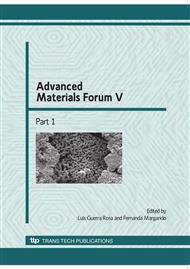p.631
p.637
p.643
p.651
p.657
p.665
p.671
p.676
p.682
The Effect of Widmanstätten and Equiaxed Microstructures of Ti-6Al-4V on the Oxidation Rate and Creep Behavior
Abstract:
Ti-6Al-4V is currently used in aeronautic and aerospace industry mainly for applications that require resistance at high temperature such as, blades for aircraft turbines and steam turbine blades. The titanium affinity by oxygen is one of main factors that limit the application of their alloys as structural materials at high temperatures. Notable advances have been observed in the development of titanium alloys with the objective of improving the creep properties. Increased oxygen levels are associated with increased microhardness and decreased ductility in titanium. In spite of this, Ti-6Al-4V containing an (+) structure continues to be the workhorse of the titanium industry due to their high specific strength, corrosion resistance, excellent high temperature properties and metallurgical stability. The objective of this work was to study the influence of equiaxed and Widmanstätten microstructures on oxidation rates and creep behavior of the Ti-6Al-4V alloy. The samples were exposed to different conditions of time and temperature to evaluate the oxidation rates. This influence on the oxidation rates was evaluated in terms of weight gain, -case depth and microhardness profile at 500 and 600 °C. Preliminary results indicated that the equiaxed microstructure with average grain size of 10 m exhibits faster oxygen diffusion. Short-term creep tests were performed under constant load in a stress range from 291 to 472 MPa at 500 °C and in a stress range from 97 to 291 MPa at 600 °C. The stress exponents obtained lie in the range from 4.0 to 11.3. The apparent activation energies for steady-state creep determined in the present work were estimated to be 316 and 415 kJ/mol at 291 MPa for the equiaxed and Widmanstätten microstructures, respectively. On the basis, the creep of Ti-6Al-4V is consistent with the lattice diffusion-controlled dislocation climb process in -Ti, for both microstructures. The creep rates of Widmanstätten microstructure were two orders of magnitude lower than of equiaxed microstructure in both temperatures. Apparently, the higher creep resistance with a Widmanstätten microstructure can be attributed to / interfaces acting as obstacles to dislocation motion and to the average grain size of 395 m, which reduces the grain boundary sliding, dislocations sources and the rate of oxygen diffusion along grain boundaries.
Info:
Periodical:
Pages:
657-662
Citation:
Online since:
January 2010
Keywords:
Price:
Сopyright:
© 2010 Trans Tech Publications Ltd. All Rights Reserved
Share:
Citation:


